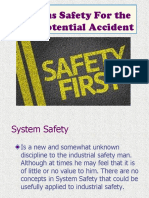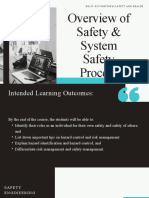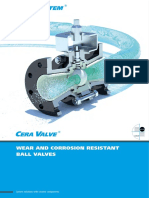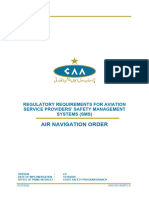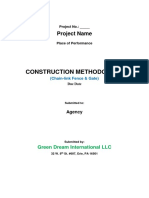Safety Management: An Introduction
Safety Management: An Introduction
Uploaded by
Nailesh MahetaCopyright:
Available Formats
Safety Management: An Introduction
Safety Management: An Introduction
Uploaded by
Nailesh MahetaOriginal Title
Copyright
Available Formats
Share this document
Did you find this document useful?
Is this content inappropriate?
Copyright:
Available Formats
Safety Management: An Introduction
Safety Management: An Introduction
Uploaded by
Nailesh MahetaCopyright:
Available Formats
Safety Management
An Introduction
Author(s)
M.J.M. Houtermans
Risknowlogy, m.j.m.houtermans@risknowlogy.com
Jabeekerstraat 10, NL-6451 CH Schinveld, The Netherlands
Published online at the ISA Safety Division
the use of standards, codes and guidelines and
1. Introduction on the other hand there are detailed safety
The ISO/IEC Guide 51 defines safety as analyses. Standards, codes and guidelines
“freedom from unacceptable risk” [1]. Therefore mainly exist because of lessons learned from the
in order to manage safety it is necessary to past, usually as a result from accidents.
understand what leads to unacceptable risk. Standards and codes deal with implementing
This understanding can be obtained with the requirements for a general process or specific
identification of important process parameters, applications based on existing knowledge, for
their possible deviations from normal conditions, example, codes and regulations for pressure
and consequences of these conditions. vessels [2] or burner management control
systems [3]. An advantage of the use of codes
To focus on safety requires a comprehensive and standards is the limited amount of effort to
understanding of the manufacturing process. It achieve acceptable safety targets. The trade off
is necessary to understand the process in terms of this approach is that only the minimum safety
of process parameters and process elements, requirements are addressed which do not
which include the necessary hardware and necessarily cover the acceptable risk of the
software that materialize the process. These specific process.
process parameters and elements need to be
understood in terms of their relationships and Safety analyses go beyond standards and codes.
possible interaction, and how deviations from In other words, analysis is useful when there is
the normal quantities, settings, or behavior can a need or desire to explicitly evaluate the risk
effect the safe operation of the process. To associated with the process, even after
achieve a safe operating plant, it is necessary to compliance with existing standards and codes.
design a process where possible deviations from It is acknowledged that implementation of
normal conditions can be kept within specific standards and safety analysis are two
limits that are dedicated by what is perceived as approaches that complement each other and
acceptable risk. that actually both should be used [4].
Compliance with the standards and codes
2. Design for Safety achieves a level of required safety, while
The “design for safety” concept can be analyses brings safety within the limits of
addressed in two ways. On one hand there is acceptable risk.
info@risknowlogy.com Copyright 2002 - 2003 Risknowlogy 1
3. Safety Analysis antagonistic manner with the other basic
properties of the system; in other words safety
Safety analysis starts usually with a hazard and
has to be carefully managed.
risk analysis. The objective of a hazard and risk
analysis is to identify all hazards and their The Department Of Energy in the US has
associated risk. It identifies what can go wrong defined five core functions for safety
and how it can be prevented or controlled. As management that comprise the underlying
result of this analysis it is possible to reduce the process for any work activity that could
associated risk to an acceptable level by either potentially affect the public, the workers, and
changing the design or adding safety measures the environment. These five core functions are
to the design. A hazard and risk analysis can (see also ) [5]:
show that specific hazards are, or are not, 1. Define the scope of work – Missions are
present after code requirements have been translated into work, expectations are
compiled with, that further safety measures are, set, tasks are defined and prioritized,
or are not, needed, and what the possible and resources are allocated.
consequence can be if the hazard causes an
accident. The outcome from the hazard and risk 2. Analyze the hazards – Hazards
analysis are recommendations to improve the associated with the work are identified,
plant design, incorporate additional safety analyzed and categorized.
measures, or define operation and maintenance 3. Develop and implement hazard controls
procedures that minimize or control potential – Applicable standards and
hazards. In other words, the objective of the requirements are identified and agreed-
safety analysis is to manage process parameters upon, controls to prevent/mitigate
or elements in terms of their deviations. The hazards are identified, the safety
next section will explain how safety is currently envelope is established, and controls are
managed in the manufacturing industry. implemented.
4. Safety Management 4. Perform work within controls –
Readiness is confirmed and work is
An industrial system can only be safe if all the performed safely.
individual elements of the system are safe and
interact with each other in a safe manner. 5. Provide feedback and continuous
Safety, like quality or profitability, is a basic improvement – Feedback information on
property of a system and needs to be addressed the adequacy of controls is gathered,
in a way that considers the individual elements, opportunities for improving the
and their interaction, within the context of the definition and planning of work are
system. The methods, techniques, and resource identified and implemented, line and
allocation must be coordinated, well planned, independent oversight is conducted, and
properly justified, and able to address the entire if necessary, regulatory enforcement
lifecycle of the system; in synergistic and not actions occur.
info@risknowlogy.com Copyright 2002 - 2003 Risknowlogy 2
Project
description
Define
scope
of work
Feedback
Analyze
and
hazards
improve
Develop/
Perform
implement
work
controls
Work
output
Figure 1. Safety Management Work Cycle [5]
right people, with the right knowledge using the
5. Conclusions right tools for the company’s situation in place.
The underlying attribute of the safety If a company is successful in this endeavor it will
management functions is the thorough and an be able to make risk-informed business
integrated understanding of the process. In decisions that enable it to manage safety in an
practice the challenge for sound safety for the company economically responsible
management will therefore deal with having the manner.
References
1. ISO/IEC Guide 51 second edition, draft, 1997.
2. EEC/97/23, Directive Of The European Parliament And Of The Council On The Approximation Of The
Laws Of The Member States Concerning Pressure Equipment, May 1997.
3. EN 298, Automatic gas burner control system for gas burners and gas burning appliances with or
without fans. European Norm EN298.
4. Leveson N.G., Safeware, System Safety and Computers. Addison Wesley, September 1995.
5. Integrated Safety Management System Description, Lawrence Livermore National Laboratory, Version
3.0, February 14, 2000.
info@risknowlogy.com Copyright 2002 - 2003 Risknowlogy 3
You might also like
- PAS 79-1 (2020) Download - Fire Risk Assessment - Non HousingDocument144 pagesPAS 79-1 (2020) Download - Fire Risk Assessment - Non HousingAaron Fillis100% (1)
- Process Safety PhilosophyDocument20 pagesProcess Safety Philosophyvyto100% (3)
- Iso 27001Document183 pagesIso 27001schadrac1100% (7)
- Assignment #3 Risk Assessment 2Document22 pagesAssignment #3 Risk Assessment 2L Yagami0% (1)
- BSBWHS616 Student Assessment TasksDocument8 pagesBSBWHS616 Student Assessment TaskskEBAY0% (1)
- HSE Risk ManagementDocument9 pagesHSE Risk ManagementSamuelFarfan100% (1)
- Safeguarding Against Falling Objects (Draft)Document21 pagesSafeguarding Against Falling Objects (Draft)lwin_oo2435No ratings yet
- Process Safety and Functional SafetyDocument4 pagesProcess Safety and Functional Safetyguillermo_pacanins100% (1)
- RMIT Risk Assessment FormDocument3 pagesRMIT Risk Assessment FormJas DhillonNo ratings yet
- HAZAN Analysis Full Project ReportDocument53 pagesHAZAN Analysis Full Project Reportthirunavukarasu0% (1)
- Bas - PSFDocument20 pagesBas - PSFhugo.tec.enf.trabNo ratings yet
- Bbs Preventive ToolsDocument6 pagesBbs Preventive ToolsEmmanuelNo ratings yet
- Schneider 62443 MaintainDocument7 pagesSchneider 62443 MaintainhvananthNo ratings yet
- Element 3 (3.5-3.8)Document61 pagesElement 3 (3.5-3.8)Arianna KhanNo ratings yet
- 10 Systems Safety For The High-Potential AccidentDocument29 pages10 Systems Safety For The High-Potential AccidentKevin JaroNo ratings yet
- Integrated Safety ManagementDocument7 pagesIntegrated Safety ManagementFernandoCrespoMonNo ratings yet
- Safety Management, Mamsm701 by Nzayirambaho JMV - 2024Document218 pagesSafety Management, Mamsm701 by Nzayirambaho JMV - 2024ringuyenezagabriel1No ratings yet
- BBS 1-1-dDocument13 pagesBBS 1-1-dabd el fattah mohamedNo ratings yet
- Unit-III SafetyDocument38 pagesUnit-III SafetySudarshan GopalNo ratings yet
- Safety Risk Assessmnet and Safe Systems of WorkDocument29 pagesSafety Risk Assessmnet and Safe Systems of WorkghtyNo ratings yet
- M.E-ISE-2022-24-SM-Introduction To Safety Management-Folder No.1Document7 pagesM.E-ISE-2022-24-SM-Introduction To Safety Management-Folder No.1Veeramuthu SundararajuNo ratings yet
- 15JF Brady PDFDocument8 pages15JF Brady PDFitung23No ratings yet
- Review of Related LiteratureDocument6 pagesReview of Related LiteratureAriel GamboaNo ratings yet
- Safe Systems of Work: Health and Safety Guidance NoteDocument5 pagesSafe Systems of Work: Health and Safety Guidance NotewawaasderNo ratings yet
- 2.3.2.1 Safety Management System NotesDocument9 pages2.3.2.1 Safety Management System Noteskit_mak_5No ratings yet
- Managing Safely v5 Course SyllabusDocument5 pagesManaging Safely v5 Course SyllabusYuri Dias SobrinhoNo ratings yet
- ARAMIS Audit Manual. Version 1.3.: November 2004Document94 pagesARAMIS Audit Manual. Version 1.3.: November 2004BernardoCruzNo ratings yet
- Ms Course Syllabus TurkishDocument5 pagesMs Course Syllabus TurkishHaseeb MahmoodNo ratings yet
- Systems Safety For The High-Potential AccidentDocument29 pagesSystems Safety For The High-Potential AccidentArvin OmboyNo ratings yet
- Safety and RiskDocument16 pagesSafety and RiskVidula KNo ratings yet
- Final Test of System Safety - Julian Hanggara AdigunaDocument6 pagesFinal Test of System Safety - Julian Hanggara AdigunaThe Minh NguyenNo ratings yet
- PCM Part 2 Compilation PDFDocument53 pagesPCM Part 2 Compilation PDFmatt jaudianNo ratings yet
- 4B.IEC 61508 Intro PDFDocument12 pages4B.IEC 61508 Intro PDFHardik MantriNo ratings yet
- Net ForensicsDocument12 pagesNet ForensicsRamesh KumarNo ratings yet
- FAA System Safety Handbook, Chapter 8 - Safety Analysis - Hazard Analysis TasksDocument36 pagesFAA System Safety Handbook, Chapter 8 - Safety Analysis - Hazard Analysis TasksPina Korbacs100% (1)
- Risk Based Process SafetyDocument5 pagesRisk Based Process Safetykanakarao1No ratings yet
- Safety in The OilfieldDocument5 pagesSafety in The OilfieldNasser YahaNo ratings yet
- Overview of Safety & System Safety Process2Document22 pagesOverview of Safety & System Safety Process2Xerxa LinganNo ratings yet
- Construction Safety Training-CreativeDocument19 pagesConstruction Safety Training-CreativeJinu Saji100% (1)
- A Study of Solid Waste ManagementDocument12 pagesA Study of Solid Waste Managementpravinsulakhe74No ratings yet
- Hand Out Maintenance Course For EngineersDocument109 pagesHand Out Maintenance Course For EngineersGauravNo ratings yet
- Block 2Document94 pagesBlock 2Najma FarooqNo ratings yet
- SMS CourseDocument271 pagesSMS CourseSherif AbbasNo ratings yet
- 16oet08 - Safety Engineering - Question BankDocument58 pages16oet08 - Safety Engineering - Question BankSulthaniya BeeviNo ratings yet
- Handbook For The NEBOShDocument83 pagesHandbook For The NEBOShAndi RahamantoNo ratings yet
- HPM 819Document7 pagesHPM 819hksinghsengarNo ratings yet
- Process Safety PhilosophyDocument10 pagesProcess Safety PhilosophyLuisma Vico GuerreroNo ratings yet
- 7 10 General IndustrialDocument6 pages7 10 General IndustrialFazle Riaz KhanNo ratings yet
- Schneider 62443 AssessmentsDocument10 pagesSchneider 62443 AssessmentshvananthNo ratings yet
- Chapter 3 Industrial SafetyDocument5 pagesChapter 3 Industrial SafetyvikkykambleNo ratings yet
- Project Title - Safety in Oil & Gas IndustriesDocument9 pagesProject Title - Safety in Oil & Gas IndustriesthiruNo ratings yet
- Information Security Risk Management StandardDocument5 pagesInformation Security Risk Management StandardNahom DejeneNo ratings yet
- Process Safety ManagementDocument5 pagesProcess Safety Managementpatrickandreas77100% (2)
- Workplace Health and Safety Programmes: Unit 4 SectionDocument6 pagesWorkplace Health and Safety Programmes: Unit 4 SectionBabamu Kalmoni JaatoNo ratings yet
- 2006 - Marono - The PROCESO' Index A New Methodology For The Evaluation of Operational Safety in The Chemical IndustryDocument13 pages2006 - Marono - The PROCESO' Index A New Methodology For The Evaluation of Operational Safety in The Chemical IndustrynmosilvaNo ratings yet
- Risk Engineering Position Paper 04 Process Safety Performance Indicators 2015Document21 pagesRisk Engineering Position Paper 04 Process Safety Performance Indicators 2015sgraureNo ratings yet
- Safety ManagementDocument26 pagesSafety ManagementSAYED100% (9)
- BLE 1213 MUST (PSY - Session 1)Document45 pagesBLE 1213 MUST (PSY - Session 1)jothi subraNo ratings yet
- PAPER - A Framework For Estimating Information Security Risk Assessment Method Completeness - CURFDocument19 pagesPAPER - A Framework For Estimating Information Security Risk Assessment Method Completeness - CURFFrancisco CastilloNo ratings yet
- Behavior-Based Safety Approach at A Large Construction Site in IranDocument5 pagesBehavior-Based Safety Approach at A Large Construction Site in IranSakinah Mhd ShukreeNo ratings yet
- Risk Based Process SafetyDocument5 pagesRisk Based Process Safetymohamed_sahnoun_enisNo ratings yet
- PRISM Safety Training Element - Gap AnalysisDocument3 pagesPRISM Safety Training Element - Gap AnalysisEfa KhairiNo ratings yet
- CompTIA CASP+ Certification The Ultimate Study Guide To Master the Advanced Security Practitioner ExamFrom EverandCompTIA CASP+ Certification The Ultimate Study Guide To Master the Advanced Security Practitioner ExamNo ratings yet
- Class: Syllabus For CCO Is Available atDocument5 pagesClass: Syllabus For CCO Is Available atNailesh MahetaNo ratings yet
- Select The Correct Option To Answer Every Question Given Below. Class - 2Document17 pagesSelect The Correct Option To Answer Every Question Given Below. Class - 2Nailesh MahetaNo ratings yet
- Class: Syllabus For CRO Is Available atDocument4 pagesClass: Syllabus For CRO Is Available atNailesh MahetaNo ratings yet
- NK Sir Class 1: VWAP: Volume Weighted Average PriceDocument4 pagesNK Sir Class 1: VWAP: Volume Weighted Average PriceNailesh MahetaNo ratings yet
- Complete Spellings Correctly For The Pictures Below and Select Correct Options To Get The Complete MarkDocument8 pagesComplete Spellings Correctly For The Pictures Below and Select Correct Options To Get The Complete MarkNailesh MahetaNo ratings yet
- Q2FY19 Earnings Report Oracle Financial Services Software LTDDocument4 pagesQ2FY19 Earnings Report Oracle Financial Services Software LTDNailesh MahetaNo ratings yet
- 10winning Strategies PDFDocument45 pages10winning Strategies PDFNailesh MahetaNo ratings yet
- Cera ValveDocument36 pagesCera ValveNailesh MahetaNo ratings yet
- Drill Floor Safety Manriding Guidance 2016Document23 pagesDrill Floor Safety Manriding Guidance 2016Lesly RiveraNo ratings yet
- CCW Action Plan - GAP ANALYSIS ON SAFETY MANAGEMENT SYSTEMDocument14 pagesCCW Action Plan - GAP ANALYSIS ON SAFETY MANAGEMENT SYSTEMVinod GuptaNo ratings yet
- 052 Surveying, Setting Out and Site InspectionsDocument2 pages052 Surveying, Setting Out and Site InspectionsjoemoalwilliamsNo ratings yet
- Incident Root Cause Analysis - Nm060418 - Using The Ladder in Unsafe MannerDocument14 pagesIncident Root Cause Analysis - Nm060418 - Using The Ladder in Unsafe MannerJayvee Baradas ValdezNo ratings yet
- BS EN 62676 Standards For CCTV: Graded Requirements UnderDocument36 pagesBS EN 62676 Standards For CCTV: Graded Requirements UnderGinesTomellosoNo ratings yet
- A Simple Method of Risk/Hazard Assessment in DredgingDocument5 pagesA Simple Method of Risk/Hazard Assessment in DredgingAbdul JabbarNo ratings yet
- Factors To Be Considered in Developing A SSWDocument31 pagesFactors To Be Considered in Developing A SSWAbdo Al-farsiNo ratings yet
- Ano 001 XXSP 2.0Document24 pagesAno 001 XXSP 2.0chickentikka 001No ratings yet
- Form 3 Work Health and Safety PolicyDocument7 pagesForm 3 Work Health and Safety PolicyMmc MixNo ratings yet
- Unit 3 Developing Secure Info SystemDocument4 pagesUnit 3 Developing Secure Info SystemLuvish YadavNo ratings yet
- Tree Risk Assessment FormsDocument8 pagesTree Risk Assessment FormsThiago MalpighiNo ratings yet
- Safety Risk Assessment InstructionsDocument2 pagesSafety Risk Assessment InstructionsHamed AbualulaNo ratings yet
- IT-Risk-Assessment-TemplateDocument5 pagesIT-Risk-Assessment-Templateshubhinikose1No ratings yet
- Risk Assessment Sheets 1 YfyhDocument3 pagesRisk Assessment Sheets 1 Yfyhapi-551149947No ratings yet
- Hazard Identification and Risk AssessmentDocument20 pagesHazard Identification and Risk AssessmentSaraansh SinghNo ratings yet
- Trees Cutting: R4 / BBR111, Bandar Bukit Raja 2, Klang, Selangor. 35. Trees CuttingDocument2 pagesTrees Cutting: R4 / BBR111, Bandar Bukit Raja 2, Klang, Selangor. 35. Trees CuttingRafee Pie100% (2)
- Sample Collaborative Agreement: 1. Purpose of The AgreementDocument4 pagesSample Collaborative Agreement: 1. Purpose of The AgreementmuscdalifeNo ratings yet
- PM - HSE Plan Session 6Document33 pagesPM - HSE Plan Session 6Mahdi DalyNo ratings yet
- Chain-Link Fence and Gate WorksDocument8 pagesChain-Link Fence and Gate WorksIrene Ionie Rarangol - TengcoNo ratings yet
- RA For HV and MV Installation Rev0Document18 pagesRA For HV and MV Installation Rev0salaitaosama1995No ratings yet
- Risk Assessment of Bot ProjectsDocument7 pagesRisk Assessment of Bot ProjectsDrAmit DuttaNo ratings yet
- Disaster Risk Reduction Management Plan of Kawit Elementtary SchoolDocument42 pagesDisaster Risk Reduction Management Plan of Kawit Elementtary SchoolJd Anadon100% (1)
- EMS Risk RegisterDocument5 pagesEMS Risk RegistermominNo ratings yet
- Cism Domain 2 Information Risk Management and ComplianceDocument80 pagesCism Domain 2 Information Risk Management and Compliancejustice friendsNo ratings yet
- Guidelines On OSH Risk ManagementDocument46 pagesGuidelines On OSH Risk Managementnishio fdNo ratings yet
- 31.0.10 LLA - Manual HandlingDocument4 pages31.0.10 LLA - Manual HandlingGerrit100% (2)




























